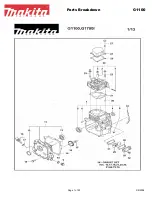
Chapter 6: Appendix
MSP 200PRO User Manual
32
International Standards Organization working on algorithm standards that allow digital
compression, storage and transmission of moving image information such as motion video,
CD-quality audio, and control data at CD-ROM bandwidth. The MPEG algorithm provides
inter-frame compression of video images and can have an effective compression rate of
100:1 to 200:1.
“NTSC”:
The color video standard used in North America and some other parts of the world
created by the National Television Standards Committee in the 1950s. A color signal must
be compatible with black-and-white TV sets. NTSC utilizes an interlaced video signals, 525
lines of resolution with a refresh rate of 60 fields per second (60 Hz). Each frame is
comprised of two fields of 262.5 lines each, running at an effective rate of 30 frames per
second.
“Operator”:
Refers to the person who uses the system.
“PAL”:
Phase Alternate Line. A television standard in which the phase of the color carrier is
alternated from line to line. It takes four full pictures (8 fields) for the color-to-horizontal
phase relationship to return to the reference point. This alternation helps cancel out phase
errors. For this reason, the hue control is not needed on a PAL TV set. PAL, in many
transmission forms, is widely used in Western Europe, Australia, Africa, the Middle East,
and Micronesia. PAL uses 625-line, 50-filed (25 fps) composite color transmission system.
“PIP”:
Picture-in-Picture. A small picture within a larger picture created by scaling down one
of the images to make it smaller. Each picture requires a separate video source such as a
camera, VCR, or computer. Other forms of PIP displays include Picture-by-Picture (PBP)
and Picture-with-Picture (PWP), which are commonly used with 16:9 aspect display devices.
PBP and PWP image formats require a separate scaler for each video window.
“Polarity”:
The positive and negative orientation of a signal. Polarity usually refers to the
direction or a level with respect to a reference (e.g. positive sync polarity means that sync
occurs when the signal is going in the positive direction).
“RJ-45”:
Registered Jack-45. A connector similar to a telephone connector that holds up to
eight wires, used for connecting Ethernet devices.
“
RS-232”:
An Electronic Industries Association (EIA) serial digital interface standard
specifying the characteristics of the communication path between two devices using either
DB-9 or DB-25 connectors. This standard is used for relatively short-range communication
and does not specify balanced control lines. RS-232 is a serial control standard with a set
number of conductors, data rate, word length, and type of connector to be used. The
standard specifies component connection standards with regard to the computer interface.
It is also called RS-232-C, which is the third version of the RS-232 standard, and is
functionally identical to the CCITT V.24 standard.
“Saturation”:
Chroma, chroma gain. The intensity of the color, or the extent to which a given
color in any image is free from white. The less white in a color, the truer the color or the
greater its saturation. On a display device, the color control adjusts the saturation. Not to
be confused with the brightness, saturation is the amount of pigment in a color, and not
the intensity. Low saturation is like adding white to the color. For example, a low-saturated
red looks pink.
“Scaling”:
A conversion of a video or computer graphic signal from a starting resolution to a
new resolution. Scaling from one resolution to another is typically done to optimize the



































